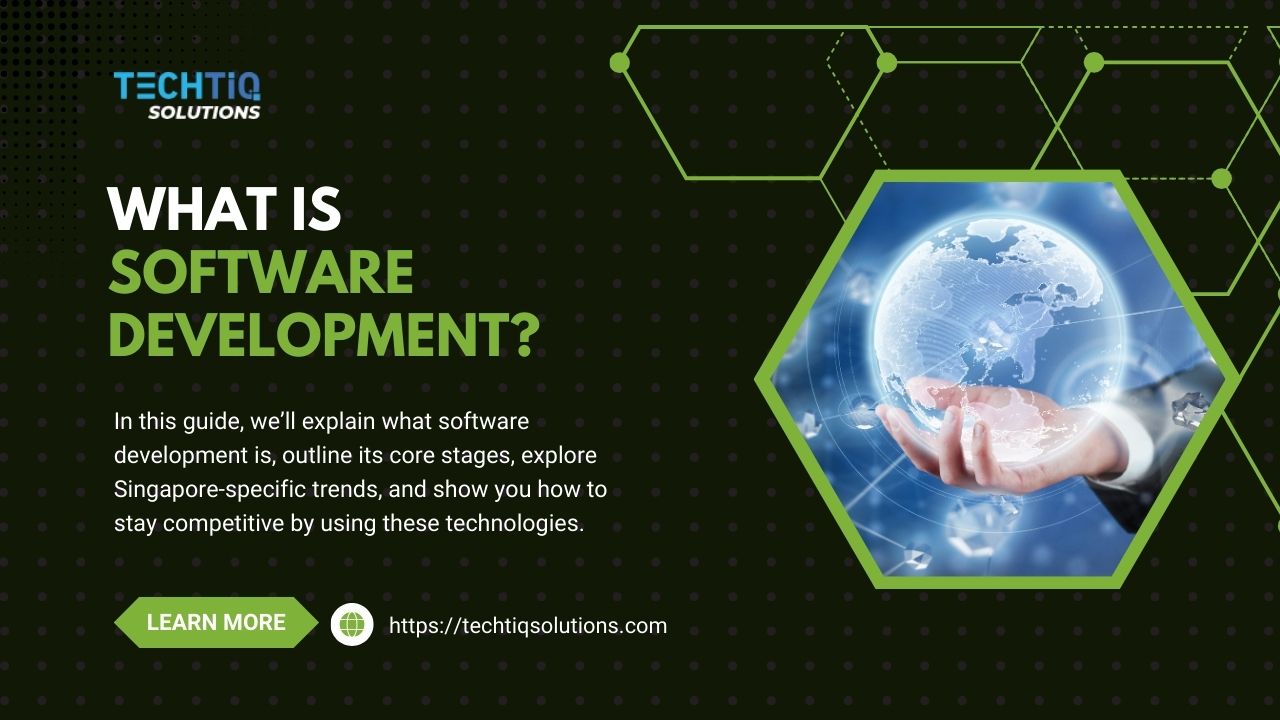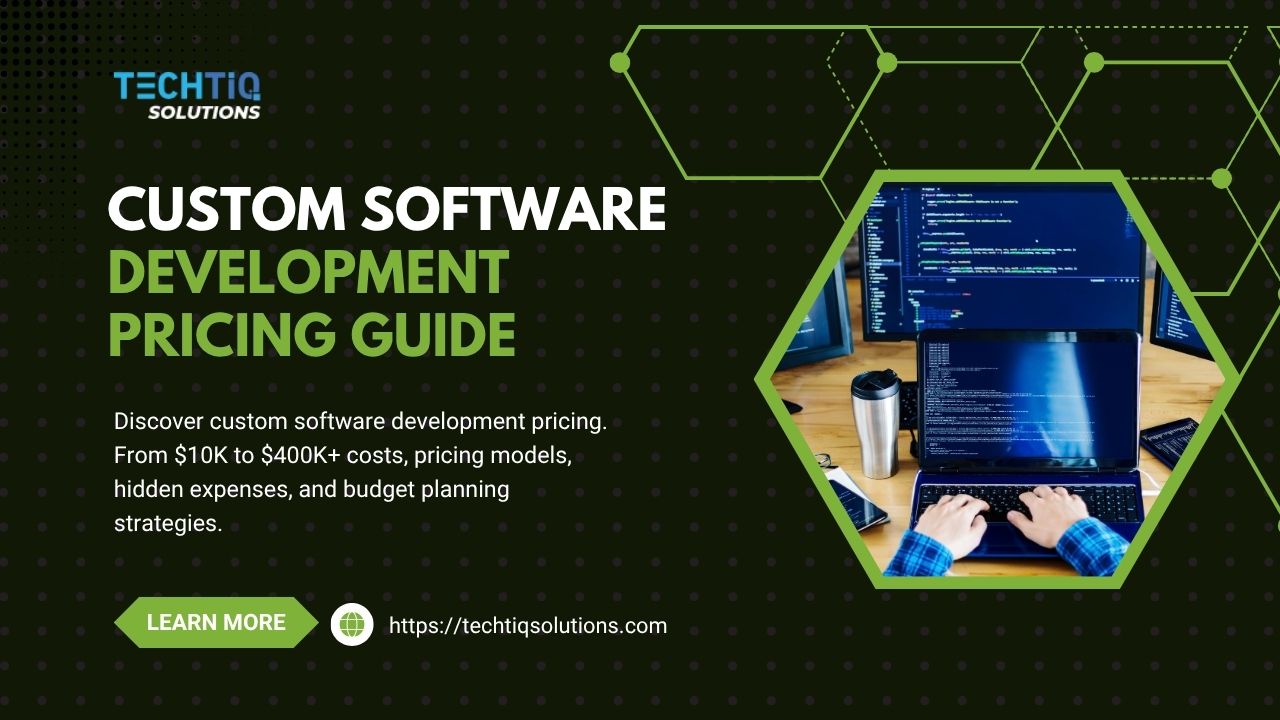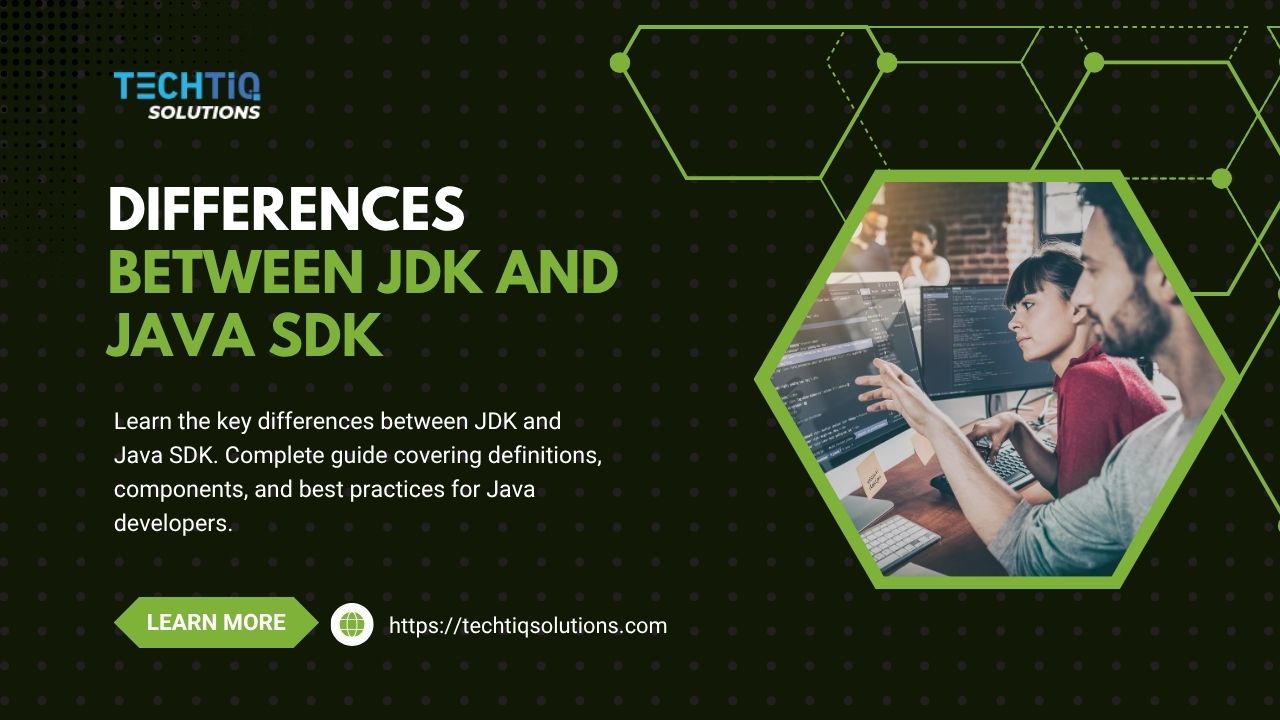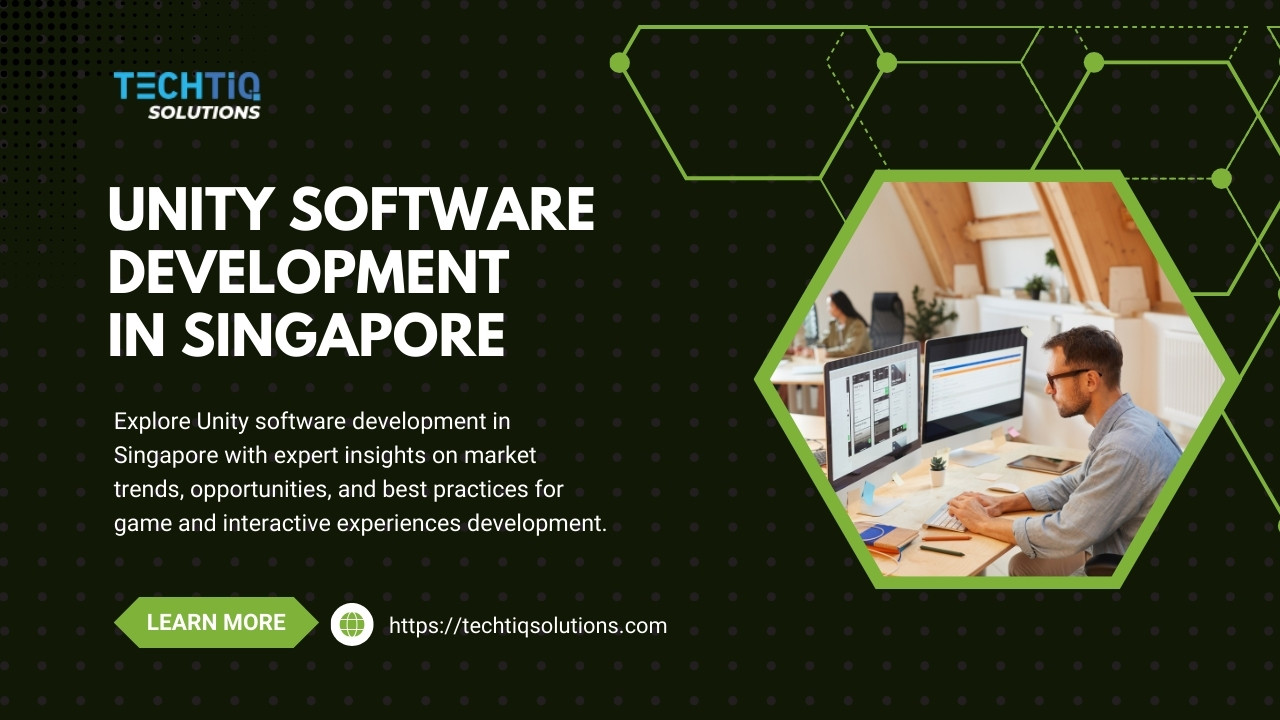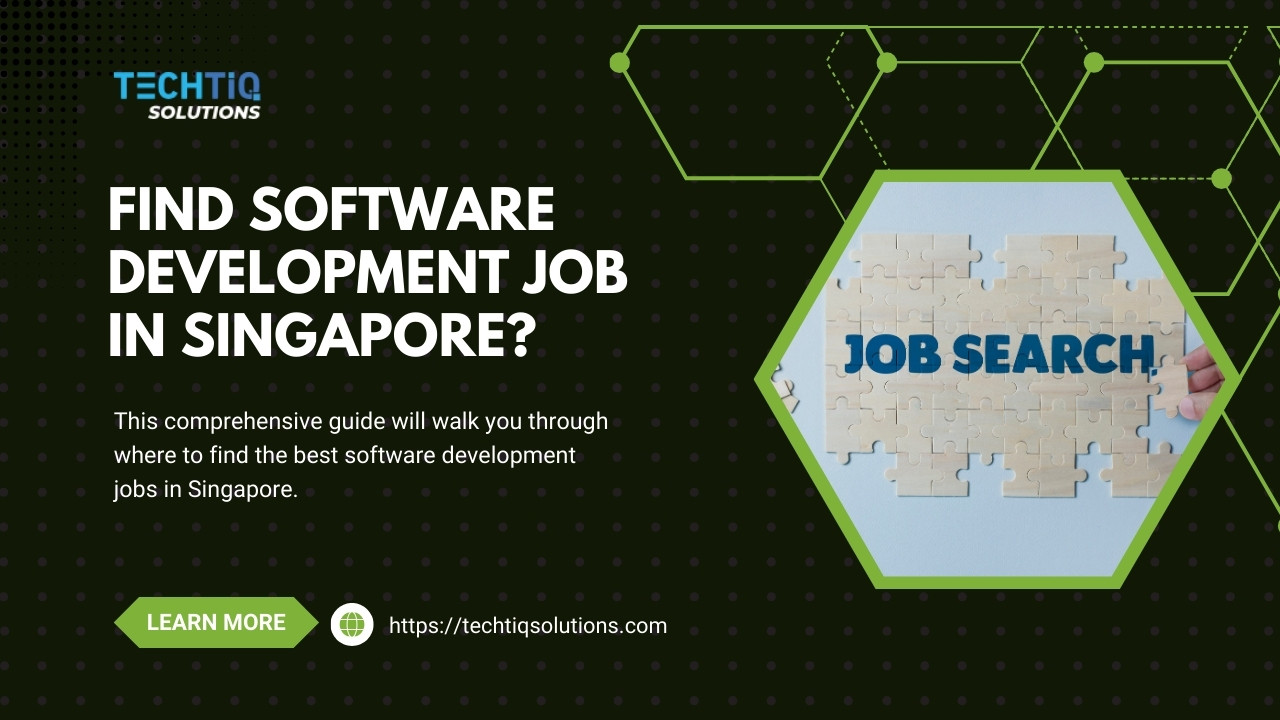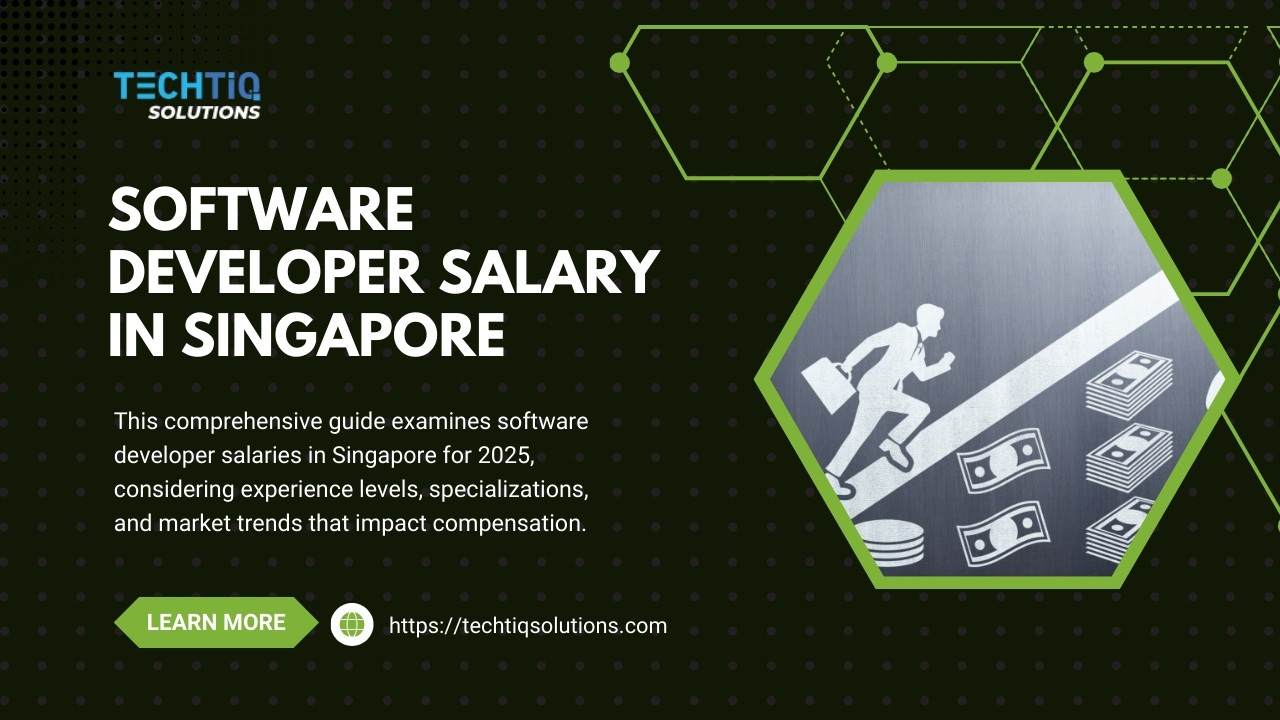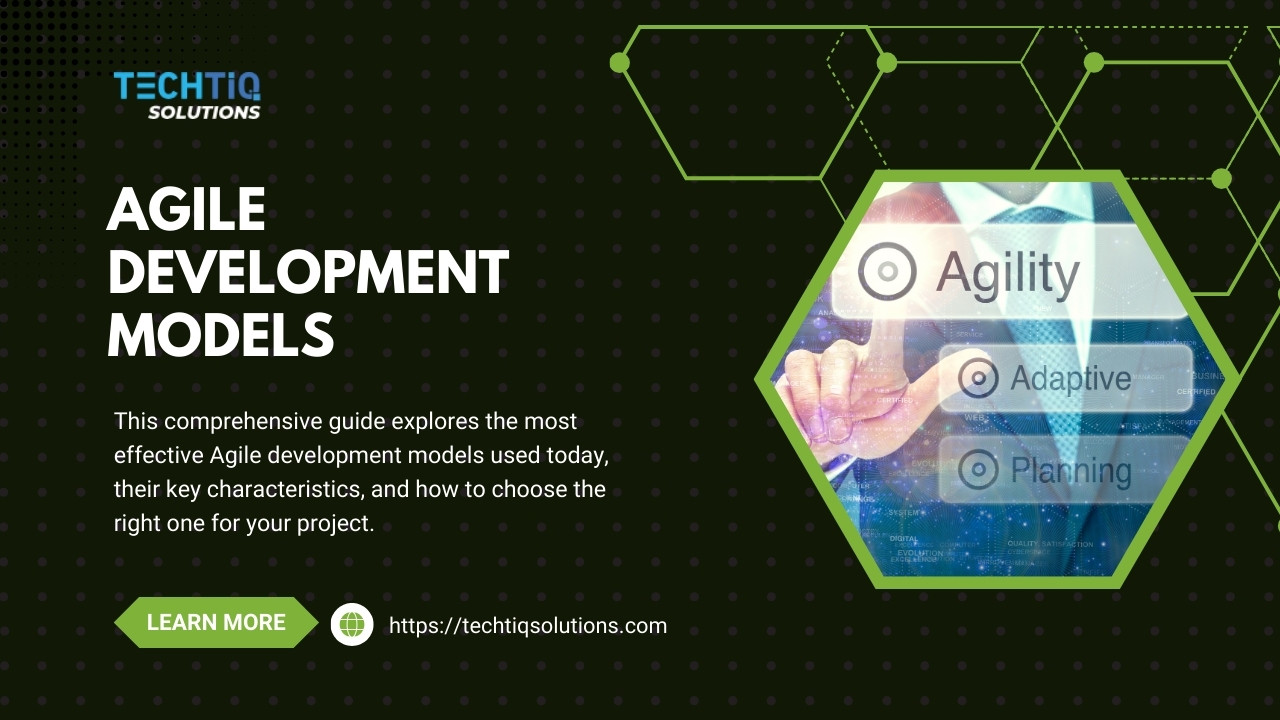The tech sector of Singapore makes up 17.7% of the country’s GDP [1]. This figure shows how crucial software development is for businesses to thrive. From local SMEs to multinational giants, many companies use software to drive innovation, streamline operations, and expand into new markets.
In this guide, we’ll explain what software development is, outline its core stages, explore Singapore-specific trends, and show you how to stay competitive by using these technologies.
Key Take-aways
-
Software development drives Singapore’s business success by powering daily operations, from e-payments to cloud-based tools.
-
By learning about the main roles in software creation, the stages of the life cycle, and the local tech scene, organizations can stay efficient and competitive.
-
AI and new technologies, such as quantum computing and green software, open fresh opportunities.
-
Companies must manage costs, develop strong talent, and meet strict regulations.
-
A reliable software partner can simplify the process, ensuring alignment with Singapore’s market and laws.
Understanding software development
What is software development?
Software development is the process of designing, creating, deploying, and maintaining computer programs or applications. It involves writing code that tells computers (ranging from personal devices to enterprise systems) how to perform specific tasks.
While hardware is the physical machinery, software is the “brain” that makes these devices practical in real life. In Singapore, software development is vital because of our focus on tech-enabled solutions. Examples include e-payments, ride-hailing apps, and cloud-based enterprise tools [1][2].
Why software development matters in Singapore
High-tech landscape in paragraph form
Singapore has a Smart Nation initiative that pushes digital transformation across many industries. This program makes software a key driver of innovation [6][11]. Local firms feel pressure to use modern tools, especially since the software development market could reach USD 42.26 billion by 2030 [12]. This environment rewards businesses that adapt quickly.
Business efficiency and automation in paragraph form
Companies often rely on ERP (Enterprise Resource Planning) and CRM (Customer Relationship Management) systems to reduce repetitive tasks and trim labor costs. In Singapore, the ERP software segment jumped from USD 218 million in 2023 and might reach USD 586 million by 2032 [3]. These numbers show that many businesses are turning to automation to improve workflows.
Global competitiveness in paragraph form
Advanced software solutions help businesses expand worldwide with fewer barriers. Singapore’s focus on AI and cloud services attracts foreign investments, boosting the country’s reputation as a regional tech hub [4][5][14]. Firms that embrace strong software can tap overseas markets and stay a step ahead of global competition.
Addressing skill shortages in paragraph form
Singapore faces more than 208,300 unfilled tech jobs today, and the nation may need 1.2 million more digitally skilled workers by 2025 [7]. Coding academies, bootcamps, and university partnerships train new developers and stimulate software innovation. This effort helps fill the gap and keeps the tech ecosystem growing.
You may also like:
Types of software
System software
System software includes operating systems (like Windows, macOS, or Linux), hardware management tools, and system utilities. It ensures other programs run smoothly. In Singapore’s banking sector, for instance, careful setup of system software is crucial to meet security and compliance demands [19].
Programming software
Programming software helps developers write, test, and maintain code. Common tools include text editors, compilers, debuggers, and version control systems like Git. These speed up coding and allow teams to collaborate, a must in Singapore’s fast-moving startup culture [2][8].
Application software
Application software focuses on specific tasks, such as office suites, media players, or data management. Many Singaporeans use mobile apps like Grab or Shopee every day, while businesses rely on apps for customer tracking, logistics, and real-time analytics.
Embedded software
Embedded software operates inside non-traditional computing devices-like wearables, industrial robots, or home systems. Under Singapore’s Smart Nation plan, embedded software supports IoT solutions, including smart lampposts, driverless vehicles, and sensors for the environment [6][11].
Custom vs. Commercial Off-The-Shelf (COTS)
-
Custom software: Tailored to specific needs. Costs may be higher at first but often offer a better return for specialized sectors like finance, healthcare, or government.
-
COTS software: Mass-produced solutions for a broad market. Cheaper to implement, though not always flexible. Singapore’s ERP market highlights how businesses often pick big-brand solutions (e.g., SAP, Oracle) to meet common needs [3].
Who develops software?
Singapore has a robust digital economy and strong government support for tech [1][4]. This means high demand for the following roles. Each role involves unique tasks and skills, and often overlaps with others in bigger projects.
Programmers (coders)
-
Tasks: Write code, fix errors, and create new features.
-
They turn specifications into working code, ensuring the program runs as intended.
-
They often work on debugging, optimizing, and reviewing each other’s contributions.
-
-
Skills: Python, Java, JavaScript, and C++ are common.
-
In Singapore, Python is popular for data analytics and AI, while Java is used in enterprise apps.
-
JavaScript powers web front-ends and back-ends via frameworks like Node.js.
-
-
Opportunities: Python and Java are top choices in Singapore’s startup world, especially for AI or fintech [7].
-
Coders can specialize in areas like web, mobile, or data science.
-
Many coders also become mentors or lead developers over time.
-
Software engineers
-
Scope: Oversee entire systems, focusing on design, testing, and alignment with business goals.
-
They plan how different parts fit together, from databases to user interfaces.
-
They also think about security, performance, and how changes will affect the whole software.
-
-
Collaboration: Work closely with project managers, product owners, and testers.
-
Engineers often refine requirements, pick suitable technologies, and guide teams.
-
They might handle code reviews or help solve complex technical issues.
-
-
Salary: Senior AI or cybersecurity engineers can earn SGD 130,000–200,000 per year [1][7].
-
This reflects high demand for specialized knowledge.
-
Experienced engineers may lead entire projects or direct R&D.
-
Software developers
-
Focus: Handle specific modules in larger software projects.
-
They might work on a web interface, API integration, or a reporting feature.
-
Some developers specialize in mobile platforms like iOS or Android.
-
-
Teamwork: Ensure that these pieces fit into a stable, user-friendly final product.
-
Developers coordinate with designers for UI and with coders for logic.
-
They also test their parts to confirm everything works smoothly.
-
-
Mobile apps: In high demand as businesses target users across multiple devices [8].
-
Many developers learn cross-platform tools like Flutter or React Native.
-
They may also explore in-app analytics or performance tuning.
-
5. Software development life cycle (SDLC)
The SDLC standardizes how software goes from an idea to a full product. Each stage has clear tasks to ensure consistency and quality. In larger teams, each step may involve different stakeholders, from business analysts to DevOps.
Planning & analysis in paragraph
During planning and analysis, teams define the project’s scope, check feasibility, and set goals. In Singapore, they also consider data laws like PDPA to avoid legal issues [1]. Budgets, timelines, and success metrics are established, and stakeholders such as clients or end-users provide input on essential features.
Requirements management in paragraph
Requirements management involves gathering user stories, performance targets, technical constraints, and budgets. The final outcome is a documented list of “must-haves” for developers. Some companies create detailed requirement specifications, including functional and non-functional aspects, ensuring compliance with local or industry-specific rules.
Design in paragraph
The design phase includes making blueprints like UI/UX prototypes, architecture diagrams, and database structures. Teams decide how external or internal APIs will connect with the application [2][8]. Designers produce wireframes to show user flows, while architects choose modules, frameworks, or patterns such as MVC or microservices.
Model building (prototyping) in paragraph
Model building involves creating early versions (prototypes) to test big ideas. Some teams use Generative AI to speed up basic layout or code creation [2][8]. Prototypes help gather quick feedback and reduce major changes later. They might be clickable front-end mockups or a minimal back-end feature for early testing.
Constructing code in paragraph
Constructing code turns designs into a working product. Developers follow coding standards, use version control like Git to track revisions, and perform peer reviews to spot errors. This phase transforms static designs into functional software, with an emphasis on security, performance, and code style.
Testing in paragraph
Testing uses both automated and manual methods to find bugs, security gaps, or performance problems. CI/CD pipelines catch issues whenever new code is merged. Testers handle unit tests, integration tests, and user acceptance checks. They may also do security scans or penetration tests, ensuring the software meets Singapore’s compliance standards.
Deployment in paragraph
Deployment moves the finished software to live servers or cloud environments. IaC scripts automate server setup on platforms like AWS or Azure [12][19]. Large teams often create a staging environment for final checks, and DevOps practices help shorten downtime during rollouts. Once deployed, the software is accessible to end-users.
Maintenance & optimization in paragraph
Maintenance involves fixing bugs, adding features, and improving performance. Monitoring tools watch for real-time alerts. Regular updates keep the software secure and extend its life. Optimization can range from refactoring code to updating dependencies, ensuring the product remains efficient and reliable.
Documentation in paragraph
Documentation explains how the software works and how to update or troubleshoot it. It might include API references, user manuals, or developer guides. Good documentation cuts confusion, speeds up onboarding, and helps external partners understand your app’s structure.
9 common software development models
Different models outline how teams follow the SDLC. Your choice depends on project size, complexity, and flexibility. Many companies blend these models to fit specific needs. Below, each model is explained first, then followed by additional details.
Waterfall
Waterfall is a linear process that flows in stages: planning, design, coding, testing, and maintenance. It works best for projects where requirements are stable and unlikely to change mid-project. Once you finish one phase, you move to the next, which reduces overlap but makes it costly to revisit earlier phases if new insights emerge.
V-Shaped
V-Shaped development pairs each step of coding with a corresponding test phase. While it ensures thorough verification and validation, it’s not ideal if needs shift often. This model is common in strict fields like healthcare or defense, where each step must pass certain checks before moving on.
Iterative
Iterative development builds software in repeated loops, adding features or refining parts each time. It catches issues sooner than a fully linear approach. Teams learn from each cycle and gradually reach a final product that’s shaped by ongoing feedback and incremental improvements.
Agile
Agile uses short sprints, frequent feedback, and welcomes changing requirements. Popular frameworks include Scrum and Kanban. This model suits Singapore’s startup world, where time-to-market is critical [8]. Each sprint delivers a functioning piece, and teams rapidly adjust plans based on user input.
DevOps
DevOps merges development with IT operations to automate releases and ensure stable code. It uses continuous integration (CI) and continuous delivery (CD) to catch errors fast. This culture breaks down silos so developers and ops teams collaborate, speeding up deployment and lowering downtime.
Rapid application development (RAD)
RAD focuses on quick prototypes and user feedback. It’s fast and flexible but can require rework if early assumptions are wrong. This model often suits GUI-based apps or in-house tools. Users see results quickly, guiding immediate changes without lengthy planning.
Spiral
Spiral is a hybrid that combines Waterfall’s structured steps with iterative loops. It’s good for large or high-risk projects where constant risk analysis is crucial. Each loop includes planning, risk assessment, and prototyping. This approach helps tackle complex systems needing multiple revisions.
Lean
Lean aims to remove waste and deliver value swiftly, taking cues from manufacturing. Teams rely on data-driven decisions and continuous improvement. They cut overhead, ditch unused features, and zero in on what users actually need.
Big Bang
Big Bang involves minimal planning before coding starts. It’s risky because projects can veer off if the scope isn’t well defined. This approach might be fine for small demos or experimental work, but it’s hard to maintain or scale for full production.
Types of software development specializations
Cloud-native development
Cloud-native development focuses on designing apps for cloud environments, using microservices, containers, or serverless architectures. Many Singapore firms choose hybrid or multi cloud setups [2][12]. This approach scales quickly and cuts infrastructure costs, but requires skills like Docker, Kubernetes, or AWS.
Low-code/no-code development
Low-code or no-code platforms let non-technical people build apps with simple, drag-and-drop interfaces. This solves some of the developer shortage [7]. Tools like OutSystems or Microsoft Power Apps can handle many basic tasks, but very complex apps still need full-code solutions.
Front-end development
Front-end development centers on how websites and apps look and feel. It uses HTML, CSS, and JavaScript frameworks like React, Angular, or Vue. A bad front-end can scare users away, so good UI/UX is crucial. Devs here also track user behavior to improve site flow.
Back-end development
Back-end dev handles server logic, data management, and security. It’s essential for apps that handle heavy traffic or sensitive data. Common languages include Java, Python, Node.js, and Ruby. This role ensures data flows well, often tying front-end features to microservices or APIs.
Full-stack development
Full-stack devs cover both front and back-end, bridging any gaps. They can reduce delays by handling tasks across the stack. However, being good at all parts is challenging. Still, full-stack devs often lead small teams where flexibility is an asset.
AI-powered software development
AI-powered development adds machine learning or data analysis features to software [2][8]. Singapore’s Enterprise Compute Initiative invests SGD 150 million in AI [4][5][14]. This helps developers create chatbots, predictive models, or recommendation engines. AI dev often overlaps with data science, focusing on algorithms and data pipelines.
AI and software development
Code generation & autocompletion
AI can help generate or suggest code snippets. This saves time on routine tasks and lets devs focus on bigger problems. Tools like GitHub Copilot or Tabnine can offer workable prototypes for basic features.
-
AI speeds up code writing.
-
Developers still check and refine the AI’s output.
AI in testing & debugging
AI-based scripts can create tests, spot performance gaps, or find security flaws. This leads to faster fixes and more stable apps. Some solutions scan code for vulnerabilities or inefficiencies.
-
Less manual testing is needed.
-
Fewer hidden issues slip through.
Deployment optimization
AI also manages releases, analyzing each code update for issues. Monitoring tools with AI can catch unusual server loads or memory leaks. Automated scaling can handle sudden user spikes.
-
Reduced downtime during updates.
-
Real-time alerts for quick responses.
Singapore’s software development market
Economic impact
Singapore’s tech sector accounts for 17.7% of the GDP in 2025 [1], and the software market might hit USD 42.26 billion by 2030 [12]. This strong demand is good for startups and established players alike. It encourages new ventures, expansions, and foreign investments.
Employment trends
There are over 208,300 open tech roles [1][7]. Salaries can climb 12–20% amid tight hiring conditions [1][7]. AI and cybersecurity skills remain the hardest to find, so firms either pay more or invest in training to fill these positions.
Government initiatives
The Smart Nation program began in 2014, aiming to digitize public services [6][11]. Public-private pilots test new solutions. Meanwhile, the Enterprise Compute Initiative sets aside SGD 150 million for AI [4][5][14], letting SMEs use advanced tools. The National Productivity Fund adds SGD 3 billion for R&D, training, and next-gen tech [10][14]. These efforts help local businesses adopt high-level solutions.
Industry-specific trends
AI, cloud, and blockchain top the list of emerging tech [2][8][12]. Contract roles keep growing for flexible staffing [1]. Mobile apps face fierce competition [8]. Sectors like biotech or finance demand specialized software to handle strict regulations or scientific processes.
Challenges
Bigger names like Google or Grab pay higher wages, making it hard for SMEs to hire [7]. Fast-evolving frameworks force teams to keep learning. Security laws like PDPA and the Cybersecurity Act require robust measures . Companies that focus on continuous upskilling, strong data protection, and positive work culture can stay competitive.
Emerging trends & innovations in Singapore software development
Blockchain integration
Blockchain can secure digital IDs, track global supply chains, or enable decentralized finance. The Monetary Authority of Singapore (MAS) pushes for safe blockchain growth [2]. Some companies explore NFTs, while others use blockchain for easier cross-border payments. Challenges include regulatory clarity and public trust.
Quantum computing
Quantum computing might transform encryption and handle massive data sets. Singapore labs are researching potential breakthroughs . If successful, quantum computers could speed up AI training or solve complex logistics puzzles. Full commercial quantum tech is still in the future, but businesses watch it closely.
Green software engineering
Green software aims to meet the “Green Plan 2030” by focusing on efficient code and eco-friendly data centers [2]. This approach reduces power use and helps cut carbon footprints. Companies optimize code for fewer CPU cycles or place servers in regions with renewable energy.
Key notes for Singapore businesses when develop or hire software development companies
Regulatory compliance
Singapore enforces rules like PDPA for personal data [1] and the Cybersecurity Act for critical systems [19]. Businesses must build in security from the start. Failing to comply can lead to hefty fines or reputation damage.
Talent & skill development
Companies can tap SkillsFuture grants for coding, AI, or security training . Universities team up with firms for real-world R&D. Some businesses also hold hackathons or on-the-job training to sharpen internal talent. Maintaining a skilled team keeps projects agile and innovative.
Cost vs. ROI
Custom solutions cost more up front but address unique challenges. A logistics firm, for instance, cut delivery times by 25% using a tailor-made route tool. Off-the-shelf (COTS) options cost less initially but may require extra workarounds. Each business weighs short-term savings against long-term benefits.
Partner selection
When choosing a development partner, look for proven domain expertise and clear communication. TechTIQ Solutions understands local rules and the Singapore market. A good partner evolves with your needs rather than just handing off a product. This fosters ongoing support, updates, and collaboration.
Conclusion
Singapore’s pro-tech mindset and government support make software development a driving force in today’s economy. Good software cuts manual labor, improves customer experience, and opens new revenue streams. Whether you’re a fresh startup or a big firm upgrading old systems, you need well-crafted code to stay ahead.
TechTIQ Solutions is a leading software development company in Singapore with top-tier expertise and over 8 years of industry experience. We understand local regulations, best practices, and the importance of tailored digital solutions. When you partner with us, we guide your projects from start to finish.
Explore our custom software development services for solutions built to match your exact needs. For larger organizations seeking robust, scalable systems, our enterprise software development services deliver top-quality platforms.
Contact us today to learn how we build secure, modern apps that fuel growth in Singapore’s vibrant tech scene. Let’s shape a more efficient, innovative future together!
FAQs on software development
What is the importance of software development in Singapore?
Software development is crucial for driving innovation, cutting costs, and reaching new markets. With Singapore’s focus on tech-enabled services, strong software is a must to stay competitive and adapt to consumer demands.
Which programming languages are most in demand among Singapore’s tech companies?
Python, Java, JavaScript, and C++ top the list. Python is popular for AI and data analytics, while Java is common in enterprise apps. JavaScript powers many web-based tools, especially in fast-moving startups.
How does Singapore’s Smart Nation initiative affect software development?
The Smart Nation plan pushes digital transformation across industries, creating big opportunities for software developers. It also raises the bar on efficiency, security, and innovation, as businesses are encouraged to adopt modern digital solutions.
What are the benefits of hiring a local software development partner in Singapore?
A local partner understands Singapore’s laws (like PDPA), regulations, and market trends. They can tailor solutions more effectively, provide ongoing support, and ensure compliance while offering easy face-to-face collaboration.
Sources of reference
-
Nucamp. (N.D.). Coding bootcamp in singapore (SGP): getting a job in tech in singapore in 2025-the complete guide. Link
-
Saigon Technology. (N.D.). Top software development companies in Singapore. Link
-
IMARC Group. (2023). Singapore ERP software market. Link
-
Computer weekly. (N.D.). Singapore pledges s150m to boost enterprise ai capabilities. Link
-
CRN Asia. (N.D.). AI and skills development remain imperative at Singapore’s budget. Link
-
Wikipedia. (N.D.). Smart Nation. Link
-
Nucamp. (N.D.). Coding bootcamp in Singapore (SGB): most in-demand tech jobs in Singapore in 2025. Link
-
Proteus DT. (N.D.). Trends in software development companies in Singapore. Link
-
Uptech media. (N.D.). Sg 2025 budget unveils bold tech innovation investments. Link
-
Smart Nation. (N.D.). vision. Link
-
IndustryARC. (N.D.). Singapore software development market. Link
-
SME Asia. (N.D.). Budget 2025: Singapore’s path to a technology-enabled future says KPMG. Link
-
Mordor intelligence. (N.D.). Singapore ICT market. Link
-
The straits times. (N.D.). Five tech trends for s’pore enterprises in 2025. Link
-
CSC. (N.D.). Digital government & smart nation: pursuing Singapore’s tech imperative. Link
-
Gov.sg. (N.D.). Smart nation report. Link
-
Yahoo news. (N.D.). Tech leaders react to budget 2025. Link
-
Smart Nation Singapore. (N.D.). Our enhanced smart nation vision. Link
-
Tech.gov.sg. (N.D.). Our digital government efforts. Link
-
The straits times. (N.D.). Budget 2025: more support for S’pore firms to tap ai solutions & financing. Link
-
EDB Singapore. (N.D.). How Singapore has become a leading force in tech innovation. Link
-
ATC.sg. (N.D.). Singapore government business SME grants support assistance. Link
-
Gov.sg. (N.D.). Smart Nation report. Link
-
Reeracoen.sg. (N.D.). Top 10 business trends to expect for Singapore in 2025. Link
-
Buuuk. (N.D.). software development trends. Link
-
Shift Asia. (N.D.). Latest technology trends in software development. Link
-
Nucamp. (N.D.). Top 10 tech companies to work for in Singapore in 2025. Link
